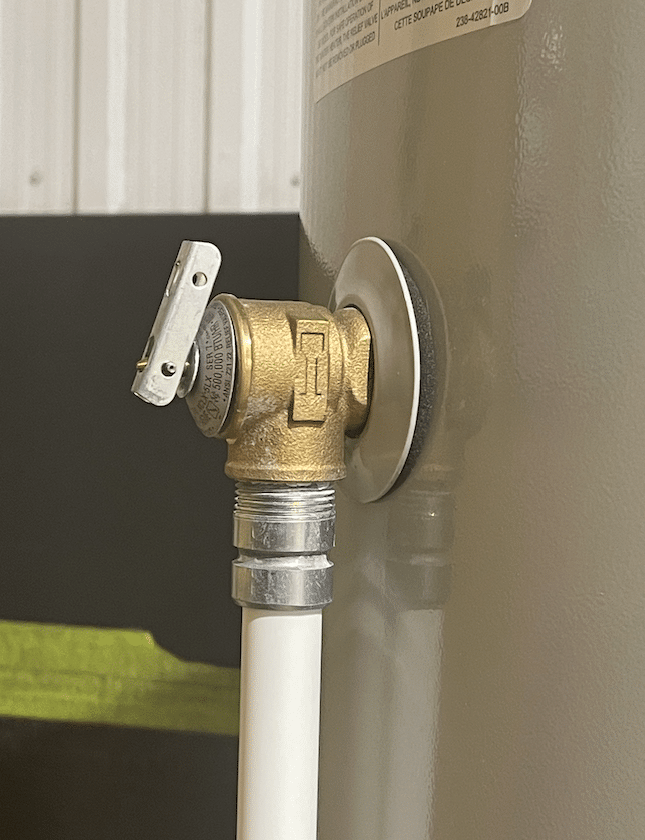Water Heater Pressure Relief Valves: What You Need to Know

Water heater pressure relief valves are essential components that protect your water heater from overheating or overpressurizing. Without them, your water heater could become a significant safety hazard. Despite their importance, these small but critical parts often go unnoticed until they fail.
What Is a Water Heater Pressure Relief Valve ?

A pressure relief valve is a safety mechanism installed on your water heater. Its purpose is to release pressure and prevent the tank from overheating or exploding. The valve activates when the pressure or temperature inside the tank exceeds safe limits, ensuring the system operates safely.
In most water heaters, the pressure relief valve is located near the top of the tank. If the valve opens, it’s connected to a discharge pipe that safely directs hot water away.
How Does a Water Heater Pressure Relief Valve Work?
Pressure relief valves monitor the internal pressure and temperature of the water heater. If either exceeds the set safety limits—usually 150 PSI (pounds per square inch) or 200°F—the valve automatically opens. This release allows hot water to escape through the discharge pipe, relieving pressure and lowering the temperature inside the tank.
Once conditions return to safe levels, the valve closes, sealing the system.
T&P valve… why does it leak?
A water heater pressure relief valve, also referred to as a T&P valve, or water heater temperature valve is a safety feature that you can find on all water heaters. The reason it’s there is to keep you safe in case the water pressure gets too high.
Two of the reasons are that there is sediment or dirt trapped inside the relief port or it is corroded and leaks.
To avoid draining the hot water heater or replacing the valve every so often, install the Corro-Protec powered anode to solve those two issues.
Why Is a Pressure Relief Valve Important ?
Without a functioning pressure relief valve, your water heater could become dangerous. High pressure or extreme temperatures could cause the tank to rupture or even explode, leading to severe property damage and potential injuries.
This valve is a small investment in your safety and the longevity of your water heater system.
Types of Pressure Relief Valves
Different water heaters require specific types of pressure relief valves to ensure optimal performance and safety.
T&P Valves (Temperature and Pressure Relief Valves)
These are the most common valves found in residential water heaters. They monitor both temperature and pressure, making them versatile and reliable.
Tankless Water Heater Pressure Relief Valves
Tankless systems don’t store water in a tank but still require a pressure relief valve. These valves help manage sudden pressure surges that can occur during operation.
RV Water Heater Pressure Relief Valves
Pressure relief valves are designed to handle fluctuations caused by movement and varying water sources in mobile systems, such as those in RVs.
Common Issues with Pressure Relief Valves
While pressure relief valves are durable, they can develop problems over time. Understanding these issues can help you identify and fix them before they cause more significant damage.
Leaking Pressure Relief Valves
Leaks are one of the most common issues homeowners face with pressure relief valves. Causes of leaks include:
- Excessive Pressure : High water pressure forces the valve to open frequently, which can lead to wear.
- Sediment Buildup : Minerals in your water can clog the valve, preventing it from sealing correctly.
- Worn-Out Valve : The valve can degrade over time, especially in older systems.
Failure Symptoms
A failing pressure relief valve can compromise your water heater’s safety. Watch for these signs:
- Constant Dripping : If the valve leaks even under normal conditions, it may be defective or clogged.
- Unusual Noises : Hissing or whistling sounds near the valve often indicate pressure issues.
- Inconsistent Pressure Release : A valve that doesn’t open when needed is a clear sign of malfunction.
Ignoring these symptoms can lead to severe problems, including tank damage or system failure.
How to Fix Pressure Relief Valve Problems
If your pressure relief valve leaks or fails to operate, here’s how to address common issues.
Replacing a Pressure Relief Valve
Replacing a faulty valve is straightforward. Follow these steps:
- Turn Off Power and Water: Shut off the gas or electricity and close the water supply valve.
- Drain the Tank : Attach a hose to the drain spigot and lower the water level below the valve.
- Remove the Old Valve : Use a wrench to unscrew the valve from its fitting.
- Install the New Valve : Apply Teflon tape to the threads of the new valve and screw it in securely.
- Restore Power and Water : Open the water supply, refill the tank, and turn the power back on.
Always test the new valve to ensure it functions properly.
When to Replace the Valve
Replace your pressure relief valve every 3-5 years or sooner if:
- It leaks excessively, even after troubleshooting.
- It shows visible signs of corrosion or damage.
- Your water heater is old and hasn’t had a valve replacement.
Specialized Applications for Pressure Relief Valves
Pressure relief valves are essential for various water heater systems, including tankless and RV models.
Tankless Water Heater Pressure Relief Valves
Tankless systems still require a pressure relief valve to handle sudden surges. These valves ensure the system operates safely during high-demand scenarios.
RV Water Heater Pressure Relief Valves
In RVs, pressure relief valves are crucial due to the unique challenges of mobile systems. Regular inspections ensure the valve remains functional despite constant movement and varying water supplies.
Maintenance Tips for Pressure Relief Valves
Routine maintenance can prevent many common issues and extend the lifespan of your pressure relief valve. Here’s how to keep it in good condition:
- Test the Valve Regularly : Lift the valve handle to release water and check if it functions properly. If no water flows, the valve may be clogged or defective.
- Inspect for Corrosion : Look for signs of rust or mineral buildup around the valve and its discharge pipe.
- Flush the Tank: Sediment accumulation can strain the valve and reduce overall system efficiency. Flushing the tank periodically removes debris.
Neglecting maintenance can lead to valve failure and compromise your water heater’s safety.
The Role of Powered Anode Rods
While the pressure relief valve is vital for safety, other components, like powered anode rods, can improve your water heater’s performance and longevity.
How Corrosion Affects Your Water Heater
Corrosion inside the tank reduces its lifespan and puts extra strain on components like the pressure relief valve. It can also cause unpleasant odors, such as the “rotten egg” smell caused by sulfur-producing bacteria.
Benefits of Powered Anode Rods
Powered anode rods offer several advantages:
- Prevents Corrosion : They protect the tank from rust, extending its lifespan.
- Eliminates Odors : Powered anode rods reduce sulfur smells, improving water quality.
- Reduces Strain on Components : By preventing corrosion, they lessen the wear on the pressure relief valve.
Purchasing and installing a powered anode rod is a proactive way to maintain your water heater and enhance its performance.
FAQ
The valve is typically near the top or side of the water heater tank, connected to a discharge pipe.
Common causes include excessive pressure, sediment buildup, or a worn-out valve.
Place a bucket under the discharge pipe, lift the handle to release water, and ensure the valve closes properly when you release the handle.
It can be hot since it’s connected to the tank and releases hot water during normal operation.
Blog
Cloudy Hot Water? Fix It In 15 Minutes!
Why is my Hot Water Cloudy? Have you ever been in this situation? You turn on the hot water, and water splashes around and the […]
Why Is My Hot Water Tank’s Overflow Pipe Leaking ?
Noticing water dripping from your hot water tank’s overflow pipe can be concerning. This pipe, known as the temperature and pressure relief (T&P) valve, is […]
